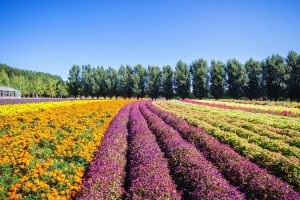
Horticulture is one of the sub sectors of agriculture that was given due attention in boosting export sector in enhancing the nation aspirations in diversifying export products and increasing export destiny. The development of horticulture plays two critical roles in the economy including foreign exchange earnings, broadening employment opportunities and modernizing agriculture supported by technology and inputs.
Ethiopia’s horticulture industry, particularly the floriculture sector, has experienced significant growth in recent years, establishing itself as a major global exporter of cut flowers. The country is now the second largest cut flower producer in Africa and a leading exporter to the European Union, with roses being a primary export.
This growth is driven by factors like favorable agro-ecology a strategic tropical location, and a robust export infrastructure. Horticulture, particularly cut flowers has been a success stories and there was expectation that this will be sustained during the plan period.
A significant shift has been envisaged during the plan period through scaling up the best practices in the horticulture industry. Targets were set to produce 9859.1 stalks of flower, 859.8 thousand tons of vegetables, and 804.4 thousand tons of fruits, respectively by the end of the plan period by the year 2024.
However performance stood at 15.7% for flower, 30.7% for vegetables, and 10.3% for fruits by the end of 2024/25. It was planned to generate 2.5 billion USD by 2024/25 from the export of flowers, vegetables and fruits, but only 985.7 million USD or 26.6% of the target was collected during the reference period. The horticulture industry still employees a large number of labor and the majority of which are women.
But given its potential, the employment opportunities created thus far leaves much to be desired. The major factors for the poor performance of the subsector were difficulties in supplying land required for development of horticulture, concentration of market destinations and inability to diversify export markets and limitation in supplying the required inputs.
Despite these experiences, there is still huge demand for investment in the horticulture industry. Given the potential of the sector in generating foreign exchange and job opportunities, addressing the bottlenecks facing the horticulture industry is very critical and will be taken up in the upcoming years.
Horticulture development was undertaken in smallholder agriculture in the 1990s which envisaged to promoting the development of commercial mechanized farming. The basic principle of mechanized commercial farming is that it exclusively relies on hitherto unutilized and unoccupied land for farming, environmental conservation or wildlife conservation.
The key objective of commercial farms development is boosting the production of industrial raw materials for domestic industrial development and exportable goods. It was planned to develop and transfer a total of 2.3 million hectares of land for the development of commercial farming during the initial period. However, only 840 thousand hectares of land was developed and transferred to investors by the end of the planned period. This fell short of the target by a significant margin.
This is identified as one of the factors that contributed to the short falls in the performance of agriculture during the start-up period. Looking forward, the country’s potential in the development of commercial farming has to be effectively unleashed for development through strengthening land administration system, recruiting high quality and high impact private investment, amplifying transparency and accountability in the sector, enhancement of environmental protection system and provision of quality infrastructure services.
According to the Ministry of Agriculture Public Relations Director Bahiru Setegn, in Ethiopia, approximately 1,700 to 3,491.04 hectares of land are dedicated to floriculture. This sector is a significant contributor to the country’s economy, generating substantial export revenue.
There are good opportunities for the development of horticulture in Ethiopia since it has suitable agro ecology (plenty of water, climate, and soil) and human power, he said.
However, horticulture development in the nation is still in infant phase. More bottlenecks can be mentioned behind the issues. Limitations of inputs (especially improved seeds and, pesticides), water management, and finance supply, irrigation canal management, controlling pesticides and disease, shortage of market linkage, infrastructures and post-harvest loss are the major ones.
Though Ethiopian agro ecology is very suitable for growing different kinds of horticultures in the presence of water alternatives, it has not harvest the expected yield yet, he underlined.
According to him, the experience of post-harvest handling practices and value addition of key fruit and Vegetables is so poor in Ethiopian context. Horticulture post-harvest loss is so worse in Ethiopian context. Limited availability of post-harvest handling equipments and material are the major attributes to the declining.
The Ministry of Agriculture is working with its stakeholders and partners to tackle such bottlenecks. Currently, the Ministry of Agriculture (MoA) has given due attention to increase the product and productivity of horticulture. Thus, the Ministry provides successive trainings to sector practitioners and small holder farmers. The main objective such as training is to reinforce the knowledge in the industry.
Recently, the Ministry organized pertinent stakeholder participatory training in Melkasa agriculture Research center. 326 development agents (DAs) and other stakeholders from different regional states, zones and community based professionals have attended a short term training in the Research Center.
The training deals with horticulture development strategy, pest prevention mechanism, among others. The training has been given targeting how to develop horticulture production, identifying pests and diseases including preventing horticulture diseases.
Horticulture Development Director at the Ministry, Abdella Negash said that the ministry is conducting different mechanisms in order to create skilled human power in the sector. Regarding this, horticulture development and irrigation training was given for 334 sector professionals and other agricultural experts.
As to him, more extension and research should be done for the development of horticulture.
He said the Ministry unveiled 10 years horticulture development and market strategy, adding that, the regional states also organized their horticulture cultivation strategy depending on the context.
“The country is managing to gain from the sector through exporting quality horticulture produces abroad. Thus, the Ministry prioritized introduction of improved seeds for farmers released from research centers like Melkasa Agricultural Research Center.
There should be successive joint interventions of organizations at all levels to make the horticulture development strategy effective,” he urged.
He urged research center to focus on promoting the sector through introducing new pests and diseases prevention mechanisms along with their respective ecological zone.
According to him, multiplication of seeds that give quality production, strong market linkage to benefit farmers from their yields, addressing post-harvest technologies for farmers, promoting skilled human power in the sector were some of the topics discussed.
The trainees who came from different parts of the country said it will enhance their capacity to maintain a productive horticulture development. Utilizing improved seeds, modernizing horticulture plantation, identifying diseases and pests immediately are the major points to be undertaken.
The training sought transforming the traditional ways of spraying chemicals by household level farmers to utilizing latest technologies in the sector. Appropriate utilization of chemicals according to different agro ecologies is important to assist a healthy horticulture growing.
Accordingly, in addition to earning significant foreign exchange horticulture is known as the driver of modernizing agriculture sector. The Ethiopian flower industry emerged in the late 1990s, and despite being a late-comer, Ethiopia has become the second largest flower exporter in Africa (after Kenya) with over 100 flower growers on 1,700 hectares according to the assessment conducted on April 2024.
The government has implemented various agricultural policies such as market liberalization, structural adjustment, Agricultural-Led Industrialization, Sustainable Development and Poverty Reduction Program, Participatory and Accelerated Sustainable Development to Eradicate Poverty and attaining successive Growth and profitability.
The main components of both sustainable farming and conventional farming are exactly the same: soil management, crop management, water management, disease/ pest management and waste management. It’s the methods used that are often radically different.
On a conventional farm, managing and maintaining soil fertility is as simple as running a soil test and applying the recommended doses of nitrogen, phosphorus, potassium and other nutrients to meet crop needs. In sustainable agriculture, soil fertility is maintained and improved through a careful rotation of crops and generous amounts of compost and green manure, which are cover crops that are plowed back into the soil to enrich organic matter.
BY ABEBE WOLDEGIORGIS
THE ETHIOPIAN HERALD WEDNESDAY 23 JULY 2025




